Free and Easy in Greece in 2012
Part B
Kalambaka: the Meteora town
The Meteora, meaning "suspended in the air", is the name given to the Eastern Orthodox monasteries built on top of sandstone peaks in north central Greece. The nearby town is Kalambaka, another 4 hours' bus ride north of Delphi, but needed to change bus twice. Shown the rocks near to the town. They are typically composed of a mixture of sandstone and conglomerate.
Kalambaka: the Monasteries
The monasteries are a UNESCO World Heritage Site. The peaks were first inhabited by Byzantine monks in the 11th century. The hermit ideal was "to be alone with God". Most of them were built in the 14th and 15th centuries, more than 20 of them. They flourished until the 17th century. Today 6 remain.
Monasteries - Roussanou
Shown below is one of them: the Holy Monastery of Roussanou, built in the 16th century. This one we did not go up. We were on a "free and lazy" tour mah! Lazy a bit. The photos are shot from the bottom of the cliff and at other vantage points using tele photo lenses.
Monasteries: Varlaam
The 1st photo shows 3 peaks. On top the middle peak is the Varlaam Monastery, the second largest complex of the 6 surviving monasteries. It was founded in the mid-14th century by a monk named Varlaam. This one we did go up, still full of enthusiasm, the first monastery visited mah!
“You climb up the 2nd peak? So steep! No way! Mission impossible! Cannot believe that. You are cheating.”
“Yes, we did. But I didn’t say we climbed up on this side. We climbed up on the other side. Look at the 1st 2 photos below. They were taken at ground level on the other side of the cliff. The monastery is just 195 leisure steps up. QED!”
At the peak is a church named “All Saints” completed in 1541. Beautiful architecture and decoration. The last photo shows the old winch system to bring up provisions and even people in a cage.
Monasteries: Great Meteoron and Holy Trinity
The Great Meteoron is the largest monastery out of the 6. And the location is not much of a cliff, 1st 2 photos. We landed on the correct low side of the cliff. But we didn't go up though because it was closed. These monasteries take turns to close one day a week.
The last 2 photos show the Holy Trinity. This one we did go up, a small monastery.
Kalambaka: the walk and the town
The 6 monasteries are quite spaced out, some several km apart. Most tourists visit the Meteora monasteries by rented cars or chartered buses if they are on group tour. We were the minority who took the special city bus to the first monastery and later walked to other monasteries. Our hotel boss told us it was easy to walk. Obviously we have different perception of what is easy. We are from the Malas-land while he is the 3rd hardest working people in Europe.
After several hours in the sun and may be 8 to 10 km later, the ladies insisted we called it a day after actually visiting 2 out of 6, and seeing another 2 from a distance. So in the early afternoon we asked a tour bus driver to help us to call for a taxi to take us back to the hotel to recuperate.
(Note in 2021: not using mobile phone in 2012.)
So in the afternoon I went alone loitering around the town. Kalambaka is a small town with about 8,000 people. The north side of the town is bordered by the sandstone outcrops. The situation must have given the house occupants a very discomforting, pressurised feeling, best described by the Chinese idiom 泰山压顶.
Some scenes of the town. The 3rd photo shows our hotel: Mythos, right at the town centre. The last photo shows the belltower of the Byzantine Church of the Dormition of Virgin Mary, built around the 11th or 12th century.
Thessaloniki: the less developed sleepy city
Thessaloniki is located at the north-eastern part of the country, the second largest city in the nation, population 320,000 in the city centre. It was mentioned in the Bible, when St Paul wrote 2 letters to the Thessalonians. Look less developed though, may be because it came under the Muslim Ottoman rules longer than other parts of the country. In fact the Ottomans ruled Thessaloniki from 1387 to 1912, over 500 years.
At the city centre buildings are mostly older and faded in paintwork. A rather sleepy city. Shown here a view of TV antenna on the roof top of the building next to our hotel. This is indeed a rare sight. Nowadays where got this kind of antenna any more in developed countries? Other places, all satellite dishes or cable TV, even in rural China.
The graffiti
Nowadays in Europe graffiti is a widespread "culture". In Greece it is no exception, and particularly "vibrant" in Thessaloniki. Here graffiti is painted even on occupied buildings and business premises, must be most annoying to the owners. May be too many unemployed youth and it is the way to show their frustration. Pity the house owner below. Shown also a shopkeeper re-painting his shop walls. But once in a while we could see delightful ones, like this giant painting on a high-rise building. This is almost certainly a commissioned painting.
The waterfront
The city does have a vibrant waterfront. The main monument is the White Tower, a drum 23 m in diameter and 33 m in height. It was built by the Turks in the mid-1400s as a defensive tower along the city wall. It is now the symbol of the city.
Thessaloniki: the Church of St Sophia
The Church of St Sophia is one of oldest churches in the country. First built in the 8th century, the design based on the Hagia Sophia in Constantinople (present-day Istanbul, Turkey). It is one of several monuments in Thessaloniki included as a UNESCO World Heritage Site. In 1430, the ruling Ottoman Turks converted it into a mosque. It was reverted back to a church in 1912.
The interior is old and dim. The interior was last restored in 1909 though the dome was restored again in 1980. The dome features the Ascension of Jesus ringed by the 12 Apostles and Virgin Mary, made with mosaic (not painted) in the 9th century. It is richly adorned with icons, typical of Eastern Orthodox churches. By the way, St Sophia is not a person, Sophia means “wisdom”.
Thessaloniki: the Catholic Cathedral
The Cathedral of the Immaculate Conception is a Roman Catholic church, a rare sight in predominantly Eastern Orthodox Greece. It was consecrated in 1900.
Thessaloniki: Monuments of Galerius
Galerius was the Roman Emperor who ruled the empire from 305 to 311 AD. During his reign he built 2 monuments which are now part of the ancient monuments listed as a UNESCO World Heritage site.
The Arch of Galerius
The Arch was built to celebrate a certain victorious battle by the emperor. It is an eight-pillared gateway forming a triple arch that was built of a rubble masonry core faced with marble panels with sculptural relief.
The Rotunda
The Rotunda is a circular building, 24.5 m in diameter built in 306 AD. The original purpose of its use is uncertain, likely a temple for a Greek deity. Its wall is 6 m thick, hence it survived many earthquakes. It was later converted into a church and to a mosque when the Ottomans took over the city. The minaret was added then. It is now a protected monument under the Ministry of Culture but the local church is allowed to use it in special festivities. The dome was under restoration at the time of our visit. Some of the original mosaic tiles are still there.
Thessaloniki: Church of St Demetrics
The Church of St Demetrius is the main sanctuary dedicated to Saint Demetrius, the patron saint of Thessaloniki. The first church on the spot was constructed in the early 4th century AD. The current one with 5 aisles dates to 629-634. It was last restored in 1949. In very good condition, both the façade and internal decorations. This is also one of the monuments grouped as a UNESCO World Heritage site.
The interior is decorated with many gilded icons, the first 2 being St Demetrius.
Thessaloniki: Museum of Byzantine Culture
We also visited this museum dedicated to Christian culture during the time of the Byzantine Empire. Many Byzantine artefacts are exhibited, like mosaic pieces and vases. The individual exhibits include a wooden panel “Virgin and St Barbara” dated to the late 15th century, a holy door featuring St Peter and St Paul dated to the 15th century, marble floral panels dated to the 13th century, and the vestment of a certain bishop dated to the 1750s.
Heraklion and Crete: the healthy big island
From Thessaloniki we took a local flight to the island of Crete to the south. Heraklion is the main city on this island, with a city population of 174,000, the 4th largest city in Greece. These Greek islands have fertile volcanic soils. Their tomatoes are excellent, in particular the cherry tomatoes. Shown tomatoes sold at only 80 Euro cents a kg at the open weekend market in Heraklion, said to be the largest open market in Europe.
Heraklion: the waterfront
A huge structure at the old port is the Koules Fortress built by the Venetians in the early 16th century, with walls up to 9 m thick. It is still in good condition. And the port is of course a terminal for yachts and cruise ships, big and small. Shown the waterfront.
More casual shots at the waterfront.
Heraklion: the tourist city
Show some street scenes of this tourist city. The 4th photo shows their famous cheese packed like a round cake for tourists. Free musical performances for the tourists too.
Heraklion: the monuments
The most famous monument is the Morosini Fountain, built in 1628 by the Venetians. At the centre of the fountain is a pedestal supported by 4 lions in the sitting position. Water flows from their mouths. Shown below one such lion. See how sad the lion look! Bemoaning the financial crisis of the nation or its own burden?
The other monument is the new Monument of National Resistance erected in 1994 to commemorate the Battle of Crete in the 2nd World War.
Heraklion: the Churches
There are many churches here, some very small.
Orthodox Cathedral
The Orthodox Cathedral of Agios Minas, completed in 1895, is the main church here. It is impressive in the structure as well as the decoration. The interior is richly and ornately adorned with frescos and iconostasis (panel of icons) in the Eastern Orthodox church tradition. Saint Minas of Egypt is the patron saint of the city.
Church of Agios Minas
Beside the Cathedral is the old Church of Agios Minas, founded in 1735. With big panels of iconostasis.
Church of Agios Titos
Shown the delightful stained glass and a chandelier.
Non-Eastern Orthodox churches
Shown the façade of the Armenian Church founded nearly 350 years ago, and that of the Basilica of Saint Mark. The latter was built by the Venetians in the 1240s. The portico shown is said to be the original. Though the name of the church remains, today it is no more a church but a monument belonging to the city council used as an art gallery and musical performances. The last 2 photos show the Catholic Church of St John the Baptist, built in 1962.
Santorini: the photographer's dream island
Santorini is a small island in the Aegean Sea, some 200 km south of Greece's mainland, with a population of 14,000. It is the remnant of a volcanic caldera, shaped like a mature crescent with steep slopes. And on the ridge of the steep slopes are built simple low buildings, usually painted in white or some pastel colours. So you have a very unique situation: steep slopes, white buildings, blue sky above and blue sea below. Such photogenic scenery continues to be featured in photography magazines.
Many years ago I have already placed this island in my list of dream destinations. And I am not alone, Santorini was ranked as the "World's Top Island for 2011" by the "Travel+Leisure" magazine. It was also named by BBC as the "World's Best Island" in 2011. Shown the caldera, the uninhabited parts and the populated slopes packed with simple buildings.
The waterfront
Santorini receives about 2 million tourists a year. Most come by the sea though it has a small airport. There are 2 ports for such sea transport. The huge cruise ships could not come near. They have to anchor at sea and visiting passengers transported via ferries. A busy waterfront.
The Blue Dome church
There are many small church-like structures with domes among the buildings on the ridge. The "blue dome" building in the next 2 photos is probably the most photographed. Blue sea, blue sky, a white church with a blue dome and a pink bell tower. Simply great setting for photos. You can see that mine don't have the sky. On the land side this church-like structure is surrounded by private houses. To have shots with the blue sky as well as the blue sea, one has to get into a private home for that angled shot. I didn't try. This building is not a real church, too small for that. It was built with a church-like exterior as a tourist attraction. And it is not alone, there are quite a few others around. And why the light/shadow on the dome on these 2 photos are so different? Because one was taken in the morning, the other in the afternoon. Miss Santorini mah, must go to see her twice.
The white buildings
Most buildings are painted white. The hotel we stayed is white (with BT), a new church is white. Even their Orthodox Cathedral is wholly white, 3rd photo. And lastly the classy looking (yes, glassy too) costume jewellery shop is white. It is my wife's favourite shop, since her husband forbid her to enter the real jewellery shop.
The Catholic Cathedral
The façade of the church is nearly white but one part of the interior, my god, is in disco-like colours. Don’t ask me why or how come. I was too stunned to find out more.
Could I buy you a drink?
Such a dream setting here: sitting on top of the cliff with your girl friend, sipping the special Santorini wine, blue sky above, blue sea below, how romantic, light breeze from the sea, especially the name of the sea in Chinese is 爱情海 (或爱琴海) or Aegean Sea. 爱情海 means "Sea of Love".
Oh, you ask me.
You took up that once-in-a-life-time opportunity?
No!
Why not?
Oh, my girl friend was not with me.
What, not spending that hour with the wife meh?
You must be crazy, or stupid, spend money on the wife!
Santorini and the Chinese
We were in Santorini on 1st and 2nd October. And this is part of the week known as "Golden Week" in China when the mainland Chinese go crazy traveling, anywhere with space. "Golden" in tourist money. And they flocked to this island of 山多於泥 too. On the rock platform where tourists waited for the best sunset view, 2 out of 5 were Chinese. On the shopping streets, to the yellow Asian faces, shopkeepers won't greet you with "kon-ni-chi-wa" anymore. They greet you with "ni hao 你好". The Chinese buying power has replaced the Japanese'. Back to photography: not much sun-set view we caught, the photo below just shows the glow of the rock from the rays of the setting sun.
Santorini the Photogenic
Showing more photos here to justify the claim it is the photographer’s paradise. This island always cloudless, hence always blue sky.
First series on the domes and bell towers.
beautiful setting
The 1st photo shows a white hotel logo against the blue sea.
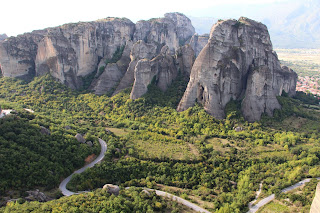
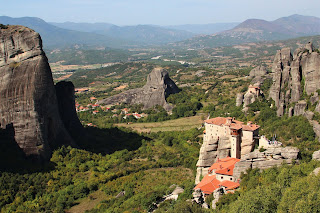
























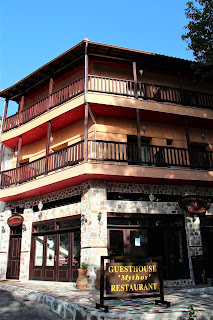



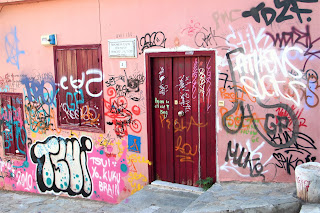









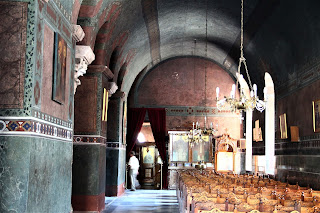






















































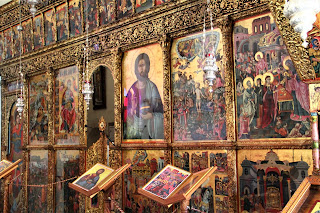







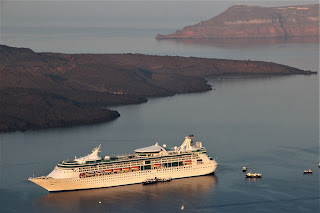


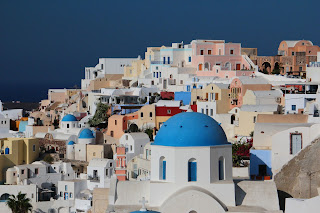




























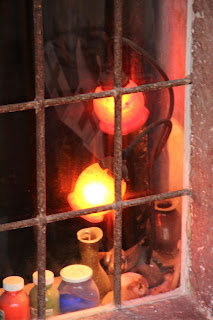

No comments:
Post a Comment